Android has been dominating the smartphone market for years. It’s the most popular OS in the world and has come a long way in creating a monopoly over the market share. Let’s take a look at the journey of Android and its current usage state as we explore the most fascinating Android statistics, facts, and insights in 2024.
Founded by Andy Rubin as an open-source alternative to the iPhone and Palm OS, Android’s true adoption started when Google acquired it in 2005. It has never looked back since then. Last year, Android peaked in usage and market share dominance, and the road ahead for the OS appears truly staggering.
Top smartphone companies like Samsung, LG, Xiaomi, OnePlus, and several others rely on the OS, and users have become fond of it. Android apps and Play Store have become an absolute necessity in our lives. Let’s quickly take a look at the key Android stats everyone should know.
Facts About The Origin & History Of Android:
Android has an interesting story of its inception and adoption. It was created by Andy Rubin as the open-source alternative to iPhone and Palm OS and then quickly became the favourite OS for most mobile manufacturers. This brief period has a story that we’ll see with the Android facts below:
- Android Inc. was founded in Palo Alto, California, by Andy Rubin, Rich Miner, Nick Sears, and Chris White in October 2003.
- The early intentions of the company were to develop an advanced OS for digital cameras.
- A few months later it diverted its efforts to become a handset OS that would rival Symbian and Microsoft Windows Mobile.

- Initially, Rubin had difficulty attracting investors, and his close friend Steve Perlman brought him $10,000 in cash to help him. He also wired an undisclosed amount as seed funding but refused to take a stake.
- In 2005, Rubin tried negotiating deals with Samsung and HTC, but then Google acquired them in July for a deal worth at least $50 million.
- Google’s then vice-president of corporate development, David Lawee, called it “the best deal ever” for the company in 2010.
- Google built an early prototype that resembled Blackberry but had to start from scratch after the launch of the iPhone in 2007.

- Eventually, Android’s focus shifted to the touch screen, which continued to rise gradually. By 2014, Android had reached one billion active users.
The adoption continued, and Android kept evolving. Almost every year, we witness new Android versions with upgrades and new features. The operating system experienced mass adoption and is now a highly dominant market leader.
Android Version History And Their Key Stats:
Android has launched eighteen major versions as of May 2023, with Android 13 being the latest. Previously, the versions were named after sweets, but now, Google has shifted to numbers. Here are all the Android versions launched till now:
- Android Versions 1.0 to 1.1 – The Early Days
- Android 1.0 version made its public debut in 2008. It didn’t have a codename, then.
- Android Version 1.5 – Cupcake
- From the launch of Android 1.5 in 2009, Google started naming the versions after sweets.
- Android Version 1.6 – Donut
- Android 1.6 was launched in the Fall of 2009 as Donut. It included major improvements.
- Android 2.0 to Android 2.1 – Eclair
- Just six weeks after Donut, the company rolled out Android 2.0 named Eclair. A few months later, its much talked about “Point One” update was launched.
- Android Version 2.2 – Froyo
- The next update came four months later and focused mainly on the backend. It was named Froyo.
- Android Version 2.3 – Gingerbread
- Gingerbread came out in 2010 and was the beginning of the true era of Android.
- Honeycomb Android 3.0 to 3
- In 2011, Google launched Android 3.0, Honeycomb, as a tablet version to accompany Motorola Xoom’s launch. The subsequent 3.1 and 3.2 updates remained tablet-specific before shifting back to mobile later.
- Android Version 4.0 – Ice Cream Sandwich
- Ice Cream Sandwich also launched in 2011 and started the new age of modern smartphone design.
- Android Versions from 4.1 to 4.3 – Jelly Bean
- Android Jelly Bean versions rolled out in 2012 and 2013. They brought significant improvements to user experience and fine-tuning.
- Android Version 4.4 – KitKat
- KitKat launched in late 2013, and it’s one of the most popular Android versions. This version bid adieu to the blues and blacks from the design.
- Android Versions of 5.0 – Lollipop
- In the autumn of 2014, Google reinvented Android with a 5.0 Lollipop.
- Android Version 6.0 – Marshmallow
- Marshmallow launched in 2015 but didn’t change the OS significantly.
- Android Versions: 7.0 – Nougat
- Nougat launched in 2016 and introduced a native split-screen mode. It also added a new bundled app system to organize notifications.
- Android Version 8.0 – Oreo
- With Orea, Android introduced features like a native image-in-picture option, a notification-snoozing functionality, and more.
- Android Version 9 – Pie
- Pie was launched in August 2018 and brought some much-needed fine-tuning.
- Android Version 10
- Google rolled out Android 10 in September 2019, and this was the first version to lose its sweet-based name. The company started naming with numbers but used dessert-based codenames. Android 10 was codenamed Android Q internal, which referred to as Quince Tart.
- Android Version 11
- Android 11 was one of the most impressive version updates. It was named Red Velvet Cake internally.
- Android Version 12
- Android 12 was launched in October 2021, and named Snow Cone internally.
- Android Version 13
- Android 13 came out last year in August. It’s one of the subtlest version changes. It was codenamed Tiramisu internally.

Going by the recent schedule, it’s expected that Google will likely roll out Android 14 with certain much-awaited upgrades in the second half of this year. One leak suggests Android 14 is codenamed “Upside Down Cake” internally.
Key Android Usage & Users Statistics:
Android took seven years to reach the first 5 million users after seven years but then hit the 1 billion user mark in 2014. Since then, it hasn’t looked back and has been dominating the smartphone users market worldwide. Here are the most interesting Android users and usage stats:
- Android has more than 3.3 billion users worldwide as of this writing. This figure was 3 billion in 2021.
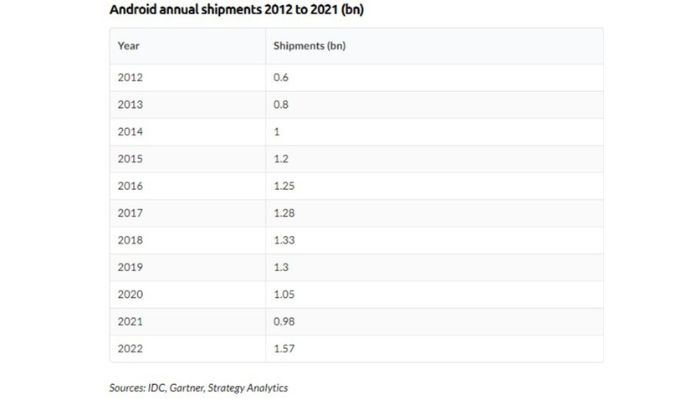
- Android owns around 71.8% of the market share of operating systems as of Q4 2022.
- In Q4 2021, Android owned 70.62% of the market share.
- Samsung is the largest Android manufacturer in the world and owns a 34% share of the overall Android market. It’s followed by Xiaomi and Oppo.

- Around 1.57 billion Android smartphones were shipped in 2022, which is the highest since its inception.
- The average selling price of an Android device was $261 as of 2021.

- Android 12 was the most version of the operating system as of 2024 with a market share of 25.1%.
- Google’s 2019 update, Android Pie 9.0, was the first version to reach over 35% of smartphones.
- Android owns a 49% share of the worldwide tablet OS market.
- The Android 13 version tablet market is around 16.86%.
- There 19.21 million units of Android tablets were shipped in 2022.
- The Samsung Galaxy A52s 5G was the best-selling Android smartphone in 2022.
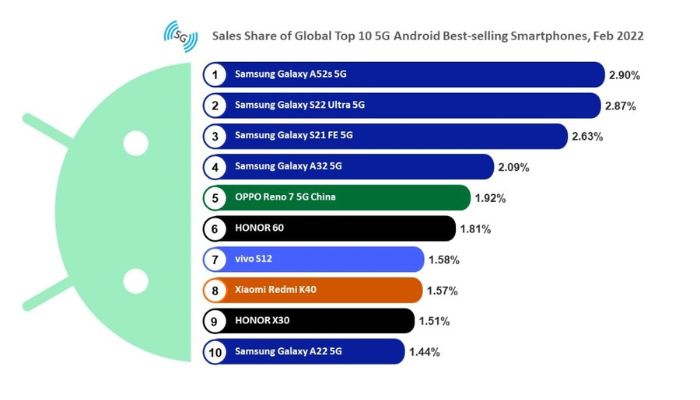
- There were 110 million Android TV active users in 2022 throughout the world. They are projected to increase by 36% and reach the 150 million mark this year.
The extent our world is dependent on Android usage is simply astonishing. If the OS were to vanish tomorrow, we couldn’t imagine how our lives would be without it.
Interesting Stats About Android Apps & Play Store:
The vast range of apps available on Android and the Google Play Store are among the core reasons behind the operating system’s immense success. Here are some very interesting stats and facts about Android apps and the Google Play Store:
- There are over 2.67 million apps available in the Google Play Store.
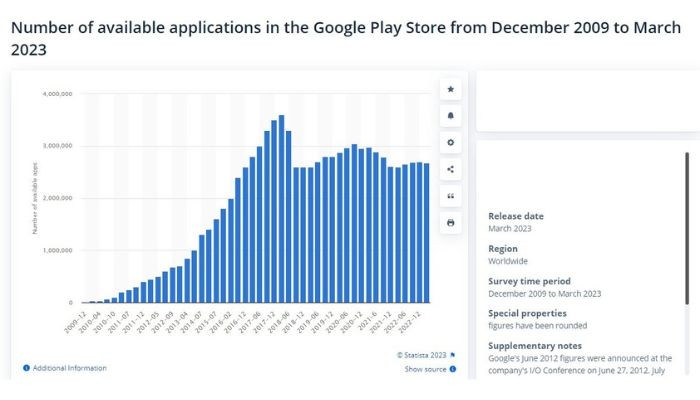
- Around 96.9% of apps in the Play Store are free.
- Around 38.5k apps in the Play Store have a price of less than $1.
- Play Store was originally launched in 2008 as Android Market. It was renamed in 2012.
- Google Play reached a revenue of $38.6 billion in 2020.
- TikTok is the most downloaded app worldwide in the first quarter of 2023 with 24 million downloads, followed by Instagram and WhatsApp with 21.17 million and 20.72 million downloads, respectively.
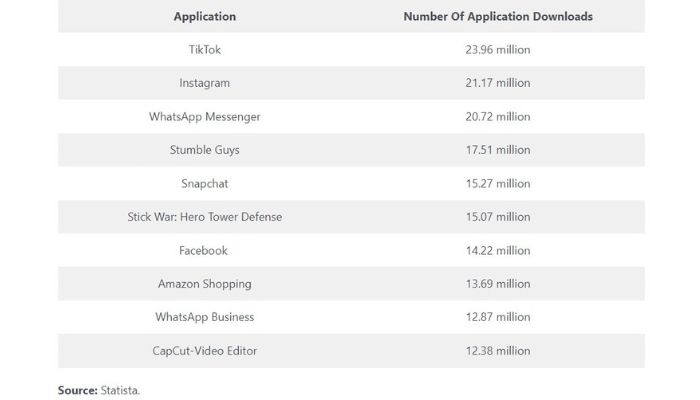
- WhatsApp is the most downloaded app on the Play Store of all time with 8.41 billion downloads, followed by Facebook with 6.95 billion downloads and Facebook Messenger with 5.67 billion downloads.
- TikTok was the top-grossing app of 2022. It generated a revenue of $2 billion in the year.
- Honor of Kings was the top-grossing game of 2022, generating $1.65 billion in revenue.
- The gaming apps on the Google Play Store earned $36 billion in consumer spending while the Apple App Store earned $51.6 billion in 2021.
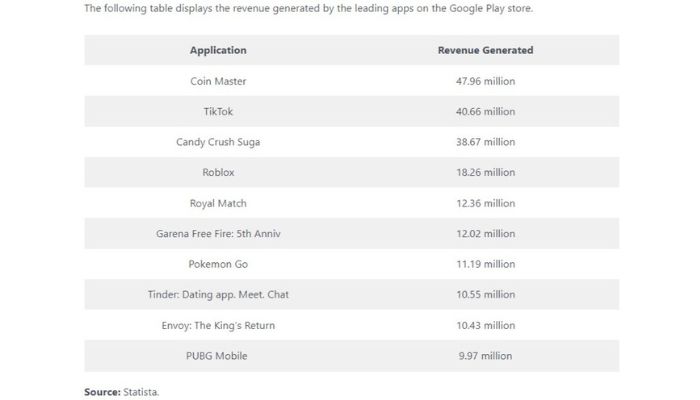
The figures shared here are just going to rise as Android continues to raise its dominance in the market.
Android vs iOS: Stats & Demographics:
Android is clearly dominating the smartphone market around the globe while iOS comes in second place. However, in some places like the United States and Japan, iOS is the market leader and Android hasn’t found a way to surpass it yet. Here are the most interesting Android statistics and demographics:
- In the United States, iOS owned 56.6% of the total market share while Android owned just 43% of it.
- In countries like Brazil, India, Indonesia, Vietnam, and Turkey, Android has over 85& of the market share.
- By 2025, it is anticipated that Android penetration in Latin America will grow to 73%.
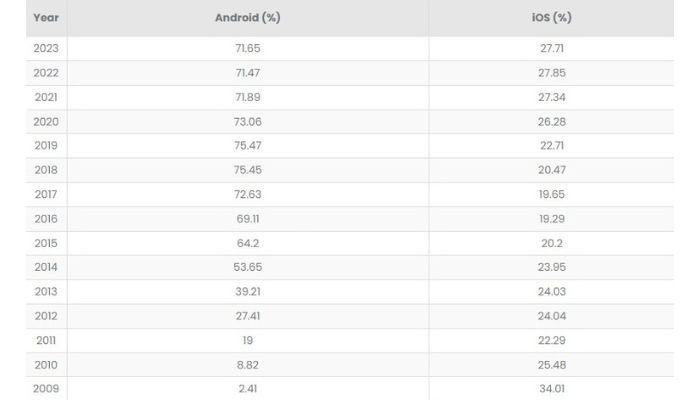
- Samsung’s market share in the U.S. was 28.57% in 2023 which is a great raise from 26.45% last year.
- According to Statista, 95% of Android users are between the ages of 18 and 49.
- 18-24 aged users make up the largest portion of Android users at around 70%, followed by 25-34 years with 65%, and 35-44 years with 58%.
- The user base of 45-54 years of age is evenly split between Android and iOS. However, people aged 55 and above show a preference for iPhones with 56% using them and only 38% using Android.
- The majority of Android users are male. Of all the users worldwide, 57% are male while 43% are female.
- In the U.S., Android has a brand penetration rate of 43.45% while iOS has that of 40.61% as of 2022.
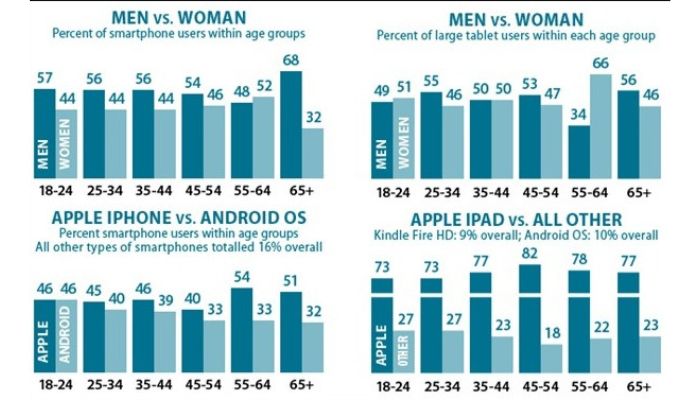
The way these two operating systems have been controlling the smartphone market is simply amazing. They combinedly form more than 99% of the market share. Other OS such as Blackberry OS, Windows, and others couldn’t keep up with their pace and have gone obsolete these days.
Fun Facts & Miscellaneous Stats About Android:
Now that we have seen all the fascinating Android statistics about users, usage, apps, revenue, and demographics, it’s time to find some miscellaneous ones. Here are some highly intriguing Android stats and fun facts you shouldn’t miss:
- Google has no control over Android in China. Instead, a host of Chinese companies operate third-party app stores on the Android platform. This accounts for 75% of all smartphone users in the country.
- People who own Android devices spend 3 hours and 42 minutes looking at their phones in a day. However, iPhone users spend around 4 hours and 54 minutes on their screen per day.
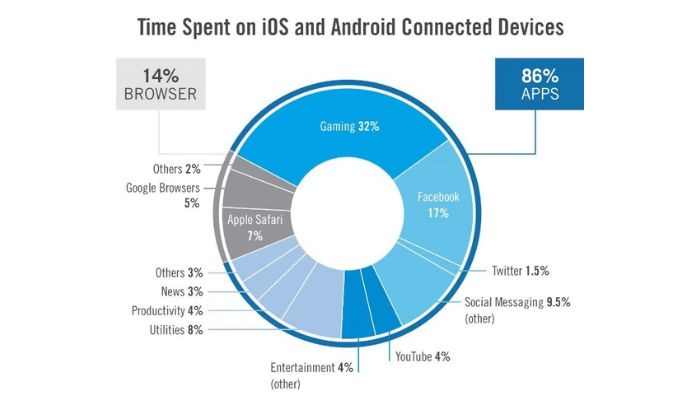
- Android users in the U.S. spent $10.4 billion on subscriptions, in-app purchases, and premium apps. Meanwhile, this figure was $21.2 billion for iOS users.
- 97% of all malware attacks are targeted on Android phones.
- Android devices are 75% more vulnerable to virus attacks than iPhones.
- The term “Android” was actually a nickname given to Andy Rubin. It was given by his former colleagues at Apple because of his love of robots.
- Android means “Male Robot.” It means a robot that carries man-like features. On the other side, a female robot is called a Gynoid. It’s not an OS yet but a framework is actually under development.
- Android’s logo was inspired by a bathroom sign. It was designed by Irina Blok.

- A survey revealed that around 57% of Android users look for discounts while making a purchase but only 25% of iPhone users do the same.
- Android has always kept a secret Easter Egg for various versions. You can find it by going to Settings- > About and then continuously tapping on the version number.
It’s truly fascinating how Android started as an operating system focusing on digital cameras but went on to lead the modern smartphone world. Had some other company bought the OS before Google, the story would’ve been a bit different. We can only speculate and get amazed by the magnificent success of Android.
Resources For The Android Statistics, Facts, And Insights:
We have gathered these Android statistics, facts, and insights after a brief research on the Internet. Here are the resources that we used to create this fascinating post:
- Wikipedia
- Statista
- Slideshare
- AppBrain
- Earth Web
- Strategy Analytics
- IGC
- Gartner
- StatCounter
- BusinessOfApps
- TechCrunch
- 9to5Google
- CounterPoint Research
- App Inventiv
- Kaspersky
- Computerworld
- Sensor Tower
- TheFactSite
- BusinessInsider
- Oberlo
Along with these, we also watched some interviews, listened to some podcasts, and went through some books. Do share this post with your friends and colleagues to appreciate our hard work.
Frequently Asked Questions:
A: There are around 3.3 billion Android users in 2024 as per the latest data.
A: The first commercial version of the OS, Android 1.0, was launched on September 23, 2008. However, the first public beta was released on November 5, 2007. Before this, internal versions of the OS were in development between 2003 and 2005.
A: Andy Rubin is the founder of Android. He established Android Inc. along with Rich Miner, Nick Sears, and Chris White in October 2003, at Palo Alto, California.
A: 71.8% of all phones in the world are Android. Apple’s iOS comes in second place with 27.6%. The two operating systems combinedly make up 99% of the whole smartphone market.
A: Android 12 is the most popular version as of 2024. Google always had a tough time getting the devices upgraded to the latest version as they were released very frequently. Users often skipped versions. 2019’s Android Pie 9.0 was the first version to reach a 35% penetration rate.
A: Samsung is the number 1 Android company and owns 34% of the overall Android market share. It is followed by Xiaomi and Oppo.
Final Verdict:
Android is the most popular operating system for mobiles in the world. The fame has come after years of development and fine-tuning to provide the best user experience. The majority of smartphone users in the world are relying on the OS while Apple continues to try and compete with iOS.
It’s fascinating how Android was recreated in 2007 with the launch of the first iPhone to compete with it. Before that, it was an operating system focusing on digital cameras which later resembled the Blackberry OS closely. Now, Android is an open-source software running on a Linux Kernel.
These were all the fascinating Android statistics, facts, and insights which are worth knowing in 2024. That’s all for this post. If you need help regarding anything mentioned here, feel free to use the comment box.
This is Saquib, a technology and social media expert with over 10 years of experience in the industry. With a passion for staying up-to-date on the latest developments and trends in the tech and social media world and as a writer, I have been creating informative and engaging content that is easy for readers to understand and enjoy, also published in several leading tech and social media publications and is a regular speaker at industry events. In addition to my writing and speaking engagements, I also work as a consultant, helping businesses grow with the ever-changing tech and social media niche.


![50 Most Beautiful Women In The World [Updated 2024] Most Beautiful Women in the World](https://www.newvisiontheatres.com/wp-content/uploads/2022/12/Most-Beautiful-Women-in-the-World-200x114.png)

![Largest Companies in The World 2024 [20 Most Valuable] Largest Companies In the World](https://www.newvisiontheatres.com/wp-content/uploads/2022/12/Largest-Companies-In-the-World-200x114.png)

